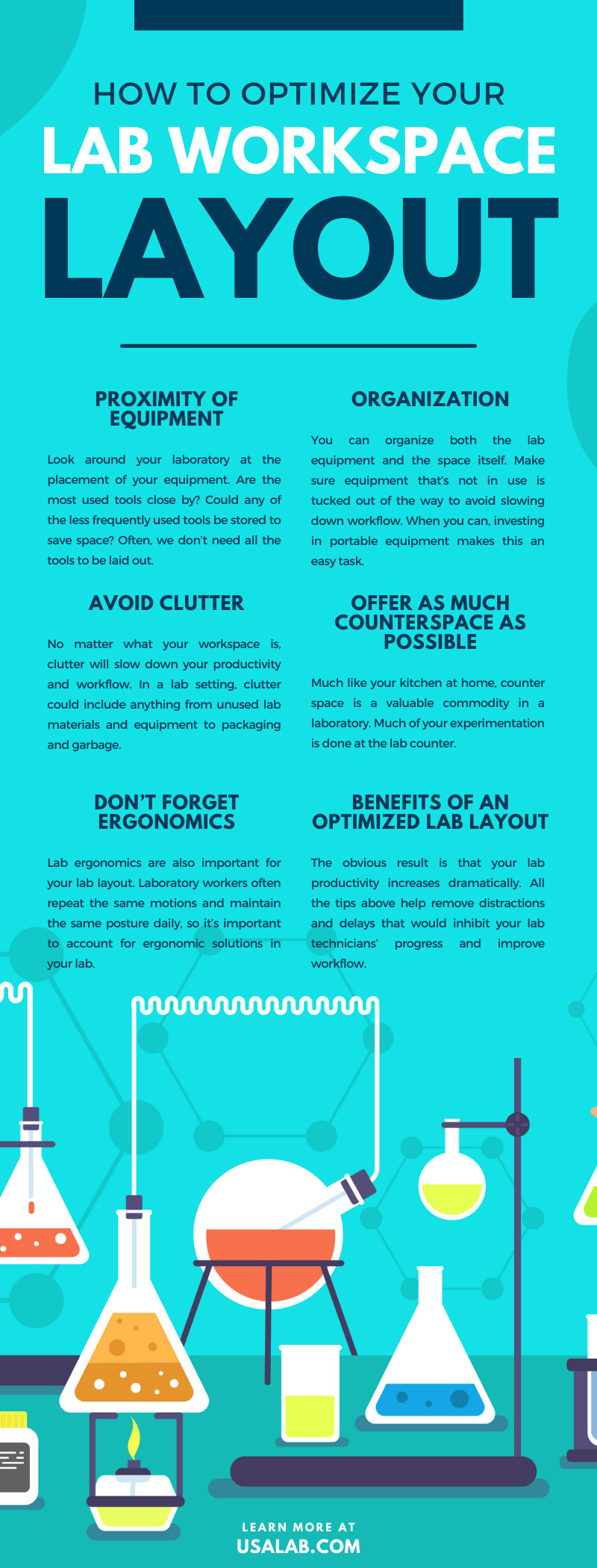How To Optimize Your Lab Workspace Layout
Posted by USA Lab Equipment on Jul 30th 2021
If you manage a laboratory, you know how difficult it can be to achieve the perfect workspace. Your laboratory workspace has a big impact on the productivity of your lab. It can be intimidating to try to tackle the lab layout because so much hinges on it, but there are a few simple steps you can follow to improve. Keep reading for the best tips on how to optimize your lab workspace layout. This guide will help you get the most out of your lab space and show you how you can improve, even when you might not see any room for it. Additionally, learn how bettering your lab environment can improve your employees’ well-being.
Proximity of Equipment
One of the first things you can switch up in your lab to promote good workflow is the placement of your materials. Look around your laboratory at the placement of your equipment. Are the most used tools close by? Could any of the less frequently used tools be stored to save space? Often, we don’t need all the tools to be laid out. If you’re not using them, they may be getting in the way of your productivity. On the other hand, always make sure that tools you use frequently are close by and don’t require you to go out of your way to reach them. For example, if you are observing specimens daily, keep the microscope station nearby instead of across the lab.
If the budget allows for it, investing in updated equipment can also help promote laboratory efficiency. New equipment may even have automation features so that your employees can direct their focus to more important tasks. If you are considering new equipment for your lab, you can buy lab equipment online through USA Lab Equipment anytime. USA Lab Equipment is your trusted source for all your online lab equipment needs.
Organization
Proper organization goes a long way in a lab setting. You can organize both the lab equipment and the space itself. Make sure equipment that’s not in use is tucked out of the way to avoid slowing down workflow. When you can, investing in portable equipment makes this an easy task. You can easily cart portable equipment around the lab to keep it nearby when you’re using it or to store it when you’re not. Keep organization strategies consistent around the lab. If you don’t, you run the risk of slowing down productivity when employees can’t find their equipment.
This is where labeling comes into play. Labeling your lab equipment, shelves, drawers, containers, stations, and more is a great way to stay organized. Labeling also helps keep everyone on the same page. When everything is properly labeled and in its place, solid organization is enforced. Labeling certain chemicals and other lab materials is crucial so chemistry or medical labs can avoid mistakes and save on material costs.
Avoid Clutter
No matter what your workspace is, clutter will slow down your productivity and workflow. In a lab setting, clutter could include anything from unused lab materials and equipment to packaging and garbage. Even if your preferred workspace is a place of organized chaos, clutter has no place in the lab. While one or two extra items in your workspace shouldn’t be an issue, an excess of clutter can and will affect your workflow. When the workflow is impacted, mistakes are made, which leads to wasted materials or even injuries. Make sure to implement a no clutter or littering policy to keep your lab space clean and organized.
Offer as Much Counterspace as Possible
Much like your kitchen at home, counter space is a valuable commodity in a laboratory. Much of your experimentation is done at the lab counter. You might find that your equipment—as well as you and your coworkers—are competing for open space. This is why decluttering is so important. All unnecessary equipment should be stored away when not in use. Doing so will save you room.
Another way to save counter space is to decide if you need your sinks or not. One or multiple sinks are necessary for chemistry and medical laboratories, but make sure you don’t end up installing too many. These features take up a lot of valuable counter space in the lab that your employees could be actively using for experimentation.
Don’t Forget Ergonomics
Lab ergonomics are also important for your lab layout. Laboratory workers often repeat the same motions and maintain the same posture daily, so it’s important to account for ergonomic solutions in your lab. You’d be surprised by how sore you can feel after awkwardly hovering over a microscope for hours on end. Soreness and injuries can greatly impact progress in your lab, so take precautions before they occur. Make sure to provide proper seating or standing desks to promote good posture in employees. Additionally, offer them breaks between repetitive motions and tasks.
Benefits of an Optimized Lab Layout
There are several benefits to optimizing your laboratory layout. The obvious result is that your lab productivity increases dramatically. All the tips above help remove distractions and delays that would inhibit your lab technicians’ progress and improve workflow. Beyond that, an organized, ergonomically friendly lab space also helps to improve employee morale. This means better employee retention and better teamwork. In the same vein, keeping an organized lab also benefits employee safety and helps reduce accidents. We should consider labs potentially dangerous spaces, so we must practice proper chemical and laboratory safety. By following these procedures and keeping materials in their proper places, we reduce the possibility of accidents and injuries.
We hope these tips for how to optimize your lab workspace layout have given you some food for thought. Consider your own lab space and what changes you may be able to make for the better. There are many benefits to improving your lab layout. By following these tips, you can use these benefits in your own lab space and promote a healthy and productive work environment.


